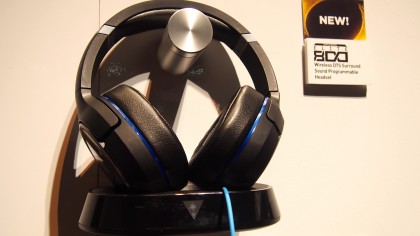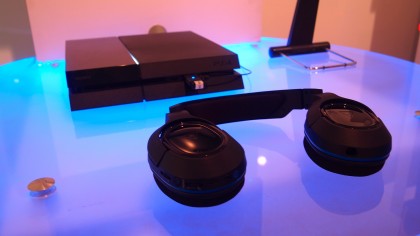Early Verdict
$300 is a lot to spend on a gaming headset, sure, but the Ear Force Elite 800 could be the best of the bunch when it comes out later this fall.
Pros
- +
Loud, multi-plane sound
- +
Sturdy build quality
Cons
- -
$300 is a lot to drop on a headset
Why you can trust TechRadar
Headset manufacturers don't always tell you the truth. Well, it's almost the truth, but not quite. Want an example? Take 360-degree sound.
You see, most headsets use simulated 7.1 surround sound with either DTS- or Dolby-powered processing to simulate the experience of seven channels of audio. Because a headset only has two drivers (left and right earcup), simulation is really almost the only way to get surround sound while using a two driver system.
That's all well and good, but for the most part true-7.1 systems are angled producing sound above and below your ears giving you a more accurate experience in line with the sound designer's intentions. Until now, that's never been possible in a headset. Enter the Ear Force Elite 800 headset for PlayStation 3 and PS4.

360+-degree audio
By simulating different planes (higher, lower, and at-ear-level), the latest headset from Turtle Beach can actually attempt to go toe-to-toe with higher-end audio setups. During my demo of Wolfenstein: The New Order, I got a chance to use the set to gun my way through a beach level in the game.
While the explosive-laden battlefield wasn't the best place to hear the finer levels of details, I could differentiate between the planes of sound. Perhaps under quieter circumstances, like, say, in a Blu-ray, this will be a bit more pronounced, but for now it's functional.
A lot has changed since the brand's initial launch on new-gen consoles. Their first PS4 and Xbox One headsets suffered from subdued audio that really provided little to no bass. Plus, at least in the Xbox One's case, weren't truly wireless.
The Elite 800 was both completely wireless - thanks to a USB dongle that plugged into the front of the PS4 - and, believe it or not, overwhelmingly loud. There's no volume issue here. The Elite 800 can output the level of sound new-gen console gamers have been craving.
Sign up for breaking news, reviews, opinion, top tech deals, and more.

Design and price
At $299.95 (UK£189, about AU$321), this set isn't exactly cheap. But the robust feature set like the downloadable Turtle Beach app that lets you choose between different presets and custom make your own,and sturdy build quality just about justify the price tag.
The Elite 800 does a lot right with its design too. Reduced padding on the bridge reduces the overall weight from previous models while keeping a comfortable, snug grip on your head. Pleather earcups provided passive noise cancellation, while software inside the headset added a relatively powerful active cancellation component.
Controls built into the headset can be accessed via the faceplate-facing side and, once you get accustomed to what they all are, the faceplate can even be exchanged for one of the dozen, franchise-exclusive sets available on the company's website.
There's not much to complain about here, and with a 15-hour battery it's not like you'll run out of juice before getting experience it all.
Early verdict
While $300 is a lot to spend on a wireless gaming headset, the Elite 800 could potentially be the best of the bunch. The possibility of including a tournament-quality audio mix-amp should finally challenge Astro's hold on the hardcore scene, and additional planes of sound should make finding enemy players in first-person shooters a breeze.

Nick Pino is Managing Editor, TV and AV for TechRadar's sister site, Tom's Guide. Previously, he was the Senior Editor of Home Entertainment at TechRadar, covering TVs, headphones, speakers, video games, VR and streaming devices. He's also written for GamesRadar+, Official Xbox Magazine, PC Gamer and other outlets over the last decade, and he has a degree in computer science he's not using if anyone wants it.
What is a hands on review?
Hands on reviews' are a journalist's first impressions of a piece of kit based on spending some time with it. It may be just a few moments, or a few hours. The important thing is we have been able to play with it ourselves and can give you some sense of what it's like to use, even if it's only an embryonic view. For more information, see TechRadar's Reviews Guarantee.
